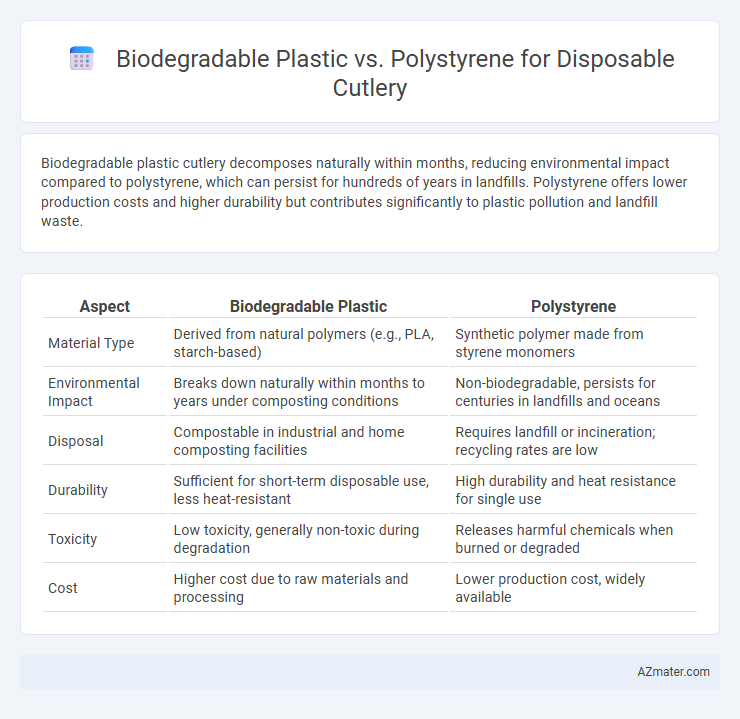Biodegradable plastic cutlery decomposes naturally within months, reducing environmental impact compared to polystyrene, which can persist for hundreds of years in landfills. Polystyrene offers lower production costs and higher durability but contributes significantly to plastic pollution and landfill waste.
Table of Comparison
| Aspect | Biodegradable Plastic | Polystyrene |
|---|---|---|
| Material Type | Derived from natural polymers (e.g., PLA, starch-based) | Synthetic polymer made from styrene monomers |
| Environmental Impact | Breaks down naturally within months to years under composting conditions | Non-biodegradable, persists for centuries in landfills and oceans |
| Disposal | Compostable in industrial and home composting facilities | Requires landfill or incineration; recycling rates are low |
| Durability | Sufficient for short-term disposable use, less heat-resistant | High durability and heat resistance for single use |
| Toxicity | Low toxicity, generally non-toxic during degradation | Releases harmful chemicals when burned or degraded |
| Cost | Higher cost due to raw materials and processing | Lower production cost, widely available |
Introduction to Disposable Cutlery Materials
Disposable cutlery is commonly made from materials such as biodegradable plastics and polystyrene, each offering distinct environmental and functional properties. Biodegradable plastics, derived from renewable resources like cornstarch or sugarcane, break down more quickly in composting conditions, reducing long-term waste accumulation. Polystyrene, a petroleum-based plastic, provides durability and low cost but poses significant challenges in decomposition and recycling, contributing to persistent environmental pollution.
What is Biodegradable Plastic?
Biodegradable plastic is a type of material designed to break down naturally through the action of microorganisms, resulting in less environmental impact compared to traditional plastics like polystyrene. Made from renewable resources such as corn starch or sugarcane, biodegradable plastics decompose into natural elements within months under proper composting conditions. This rapid degradation helps reduce landfill waste and pollution commonly associated with polystyrene disposable cutlery, which can take hundreds of years to break down.
Understanding Polystyrene: Properties and Uses
Polystyrene is a synthetic aromatic polymer known for its rigidity, clarity, and excellent insulating properties, making it widely used in disposable cutlery production due to cost-effectiveness and ease of molding. It exists in various forms, such as expanded polystyrene (EPS) for lightweight applications and high-impact polystyrene (HIPS) for enhanced durability. However, polystyrene's resistance to biodegradation poses significant environmental challenges, leading to increased interest in biodegradable plastic alternatives.
Environmental Impact: Biodegradable Plastic vs Polystyrene
Biodegradable plastic cutlery breaks down more rapidly under composting conditions, significantly reducing landfill waste and lowering long-term environmental pollution compared to polystyrene, which persists for hundreds of years and contributes to microplastic contamination. Polystyrene's production involves high energy consumption and releases toxic compounds such as styrene, adversely affecting air quality and aquatic ecosystems. Choosing biodegradable plastics mitigates carbon footprint and decreases harmful environmental residues, supporting sustainable waste management practices.
Decomposition Rates and End-of-Life Outcomes
Biodegradable plastics used for disposable cutlery can decompose within 6 months to 2 years under industrial composting conditions, significantly reducing landfill accumulation compared to polystyrene, which can take up to 500 years to break down. Polystyrene, composed of styrene monomers, resists microbial degradation and often fragments into harmful microplastics, posing long-term environmental hazards. End-of-life outcomes favor biodegradable plastics when proper composting infrastructure exists, while polystyrene disposal typically leads to persistent landfill waste and environmental pollution.
Consumer Safety and Toxicity Concerns
Biodegradable plastic disposable cutlery reduces consumer exposure to harmful chemicals often found in polystyrene, which can release styrene--a potential carcinogen--especially when heated. Studies highlight that biodegradable materials, derived from plant-based sources like PLA (polylactic acid), exhibit lower toxicity and improved safety profiles compared to traditional polystyrene cutlery. Consumer safety assessments recommend biodegradable options to minimize health risks linked to long-term chemical exposure from disposable utensils.
Cost Comparison and Availability
Biodegradable plastic disposable cutlery generally incurs higher costs due to the expense of raw materials like cornstarch or PLA, while polystyrene cutlery remains cheaper thanks to mass production and abundant petroleum-based feedstocks. Availability of polystyrene cutlery is widespread across retail and foodservice suppliers, reflecting economies of scale, whereas biodegradable alternatives are increasingly accessible but still limited in certain markets due to production capacity constraints. Cost and availability differences significantly influence the adoption rates of these materials in the disposable cutlery industry.
Performance and User Experience
Biodegradable plastic disposable cutlery offers superior environmental benefits by breaking down naturally within months, whereas polystyrene can persist in landfills for centuries, causing long-term pollution. In terms of performance, polystyrene provides better rigidity and heat resistance, making it suitable for hot foods, while biodegradable plastics may soften or deform under high temperatures, limiting their usability. User experience favors polystyrene for its sturdiness and affordability, but biodegradable alternatives are increasingly preferred by eco-conscious consumers valuing sustainability despite a slightly higher cost and occasional compromises in durability.
Regulatory Trends and Industry Shifts
Regulatory trends increasingly favor biodegradable plastic over polystyrene for disposable cutlery due to stricter environmental policies targeting single-use plastics and their ecological impact. Governments in the EU, US, and Asia have implemented bans or taxes on polystyrene products, spurring manufacturers to shift toward compostable and bio-based alternatives. Industry adoption of biodegradable plastics is accelerating, driven by consumer demand for sustainable options and advancements in material performance that meet food safety standards.
The Future of Sustainable Disposable Cutlery
Biodegradable plastic disposable cutlery offers a sustainable alternative to traditional polystyrene, which contributes significantly to environmental pollution due to its non-biodegradable nature. Innovations in biodegradable polymers, such as PLA and PHA, enable these utensils to break down efficiently in composting conditions, reducing landfill waste and ocean contamination. The future of sustainable disposable cutlery strongly favors biodegradable materials, driven by increasing regulatory pressures and consumer demand for eco-friendly products.

Infographic: Biodegradable plastic vs Polystyrene for Disposable cutlery
 azmater.com
azmater.com